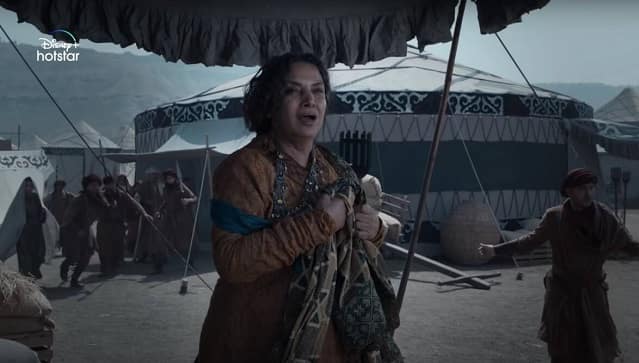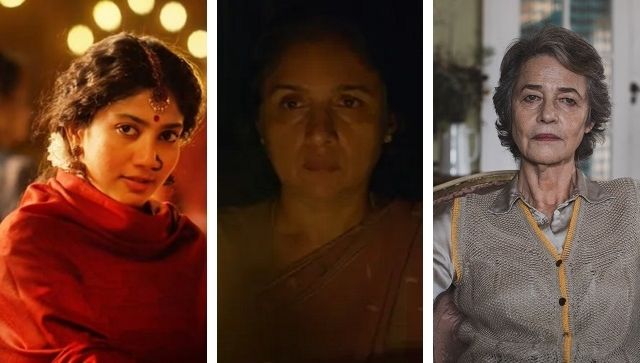The most agreeable part of watching three immeasurably beautiful women take centre stage in three very different films, in three different languages is that there is no sense of self-congratulations in the endeavour. Satyajit Ray had once confessed that when he made the exceptionally beautiful Charulata he was trying to be a young progressive artiste who understood the sensitivities of a lonely wife. I saw not an iota of self-consciousness in the way the Telugu star Nani rescues the doomed Devdasi, Sai Pallavi in the hugely engaging costume drama Shyam Singha Roy. This is as flawless and passionate a love epic as I have witnessed since Sanjay Leela Bhansali’s Devdas. Please note I say, ‘witnessed’ not ‘seen’. This is the film that incites ornate poetic descriptions of simple human activities such as eating, sleeping and courtship…Everything is done with a captivating old-world charm that’s rare to find in cinema today. Cinema today, reminds me of how lamely the film starts. When we first meet the film’s hero Vasudev, he is a struggling filmmaker who shamelessly uses a stranger as his short film’s leading lady, That whole epilogue with Keerthy (Krithi Shetty) falling for the struggling filmmaker is an aberration… But wait. Don’t go away. If you do, you will miss an epic love story told in such a gloriously florid and visually rich language that you will miss the big-screen more than ever before. I did. I have not felt so strongly about cinema exclusion since the lockdown. Writer-director Rahul Sankrityan seems to have designed the entire film for the sake of posterity: look what you missed out on the big screen when Covid crept into your lives! Suffer, all ye locked-down souls! This is a larger-than-life melodrama with the writing so clearly defined and packaged, it’s like watching a romance unfold in a familiar yet exciting language. As soon as Shyam Singha Roy moves into another lifetime—yes, this is a tale of reincarnation and a convincing one for a change—a kind of dramatic deliverance and a storytelling celerity kick in. You are hooked, mesmerised by the visual and emotional velocity of this unapologetic melodrama. You wouldn’t be able to take your eyes off the sparks and flames of mutual passion between Shyam Singha Roy and the lovely Devdasi Maithrayee, played by the bewitching Sai Pallavi(more on her later). The romance unravels in Kolkata (which means we see a painting of the Howrah Bridge in the backdrop of almost every frame) in the early 1970s.
It is a highly erotic moment, but also very spiritual in its tragic suggestions of the twilight phase in the human life specially when the flesh is weak but the spirit is high, and why not? Since Ruth sips on gin and tonic all day long. By the time the film ends the bonding between Ruth and Sam is so strong I could feel the weight of the impending tragedy on Sam’s shoulder. The weight gets heavier as we grow older. Shabana Azmi who has been a constantly powerful hero in Hindi cinema since the 1970s when she began her stunning career in Shyam Benegal’s Ankur feels the time is right for female heroes. “I always say it’s about being at the right place at the right time. I have an unconventional face for a Hindi film heroine. I remember. BR Chopra suggesting that I should do only vamp’s roles and Tarachand Barjatya saying that I look lower class and so should restrict myself to playing a maid, etc. Its another matter that later both of them cast me in roles that were far removed from the moulds they had suggested! I am amazed at the success I got in mainstream Hindi cinema and often think these films Fakira, Parvarish, Amar Akbar Anthony etc were successful in spite of me not because of me! But subconsciously something very important was happening. I was playing some very substantial roles in Parallel cinema that won me critical acclaim and several national awards so I developed a status that was equivalent to the most successful stars of those times such as Hema Malini and Zeenat Aman because I was not competing on their home ground- had I done that I’m sure I would have been on the bottom rung of the ladder but parallel cinema gave me and Smita and Naseer and Om a unique position and I will always feel indebted to the various directors and writers who cast me in strong meaningful roles.” Shabana feels there’s a wide variety of roles that are available to all kinds of actors. “I’d like to be a part of films that either offer me a substantial role, or are trying to do or say something beyond the ordinary. I find myself more and more at the right place at the right time. The kind of parts that have come my way recently were unimaginable earlier for an actress my age…Look at Morning Raga, Saaz, Godmother, Fire, Tehzeeb, Neerja and the web series The Empire….These are well-structured nuanced characters. Did anyone think ten years ago that actresses in our films would get such roles? Ten years ago it was pack-up time for heroines at 30. All you could do was hold a thali in a white saree. Today I can play my age. I abhor the thought of playing a younger woman. The camera doesn’t lie. And any attempt to not look your age is pathetic on screen. We don’t have proper facilities to look older either. Thank God, we’re playing our age. Whether it’s Amitabh Bachchan or any of us, we are not made to play younger people. Look at poor Nirupa Roy. She got substantial roles. But at the age of 30 they made her put grey in her hair. And Achala Sachdev was all of 16 when she played 60. She quit because she got nightmares about dropping a thali and screaming, ‘Nahin !’. You know an actor or any other human being needs to be comfortable in her space at whatever age she is .” [caption id=“attachment_10263121” align=“alignnone” width=“639”]
 Shabana Azmi in The Empire[/caption] The key to Shabana’s longevity is her refusal to conform. “I don’t see why I have to wear the colours that are politically correct. Who says saffron is identified with one religion and green with another? I’ll wear both colours together. And let me see who can stop me.” However one of Shabana’s favourite actresses Waheeda Rehman doesn’t share Shabana’s optimism. The beautiful and elegant Waheeda who played strong assertive women in Pyaasa, Guide, Khamoshi and Teesri Kasam has all but retired. The iconic Waheeda Rehman whose fans in the film industry range from Amitabh to Abhishek Bachchan has finally decided to call it quits. Waheedaji sighed, “Where are the roles? It’s getting tiresome to play mother and grandmother’s roles. I don’t enjoy it anymore. It’s unlikely that I’d accept anything else now. Bas, ab bahut ho gaya” The screen-legend who began her career in 1955 was last seen in Rakeysh Omprakash Mehra’s Rang De Basanti and Delhi Belly and a cameo in Skater Girl. Reminiscing about her premature switchover to mother’s roles Waheedaji said, “I got the role of a lifetime in Rajinder Singh Bedi’s Phagun in 1973. I had to play Jaya Bhaduri’s mother. That did it for me. I was suddenly flooded with mother’s roles. And I found myself playing Rajesh Khanna’s mother just 9 years after I played his leading lady in Khamoshi.” Waheedaji blames the male-dominated film industry for the premature matriarchal status accorded to leading ladies. “The heroines for our established heroes are getting younger and younger. So the heroines who started their career with these established heroes are quickly promoted to senior roles.” Ask her if she doesn’t find this unfair and Waheedaji says practically, “It’s the norm in cinema everywhere. Look at Meryl Streep. She contemplates quitting every year when Hollywood quickly offers her another role. Sadly in our industry, there’s no such remedial procedure. Once a heroine is beyond an age she has to graduate to mother’s roles or quit.” Sadly for her fans, Waheedaji who sold off her farm in Bangalore a few years ago to settle permanently in Mumbai where she lives with her son and daughter has opted to quit.“I’m happy to be doing other things. My days are full and I’ve no regrets. Please don’t expect to see me playing stereotypical roles.”
Shabana Azmi in The Empire[/caption] The key to Shabana’s longevity is her refusal to conform. “I don’t see why I have to wear the colours that are politically correct. Who says saffron is identified with one religion and green with another? I’ll wear both colours together. And let me see who can stop me.” However one of Shabana’s favourite actresses Waheeda Rehman doesn’t share Shabana’s optimism. The beautiful and elegant Waheeda who played strong assertive women in Pyaasa, Guide, Khamoshi and Teesri Kasam has all but retired. The iconic Waheeda Rehman whose fans in the film industry range from Amitabh to Abhishek Bachchan has finally decided to call it quits. Waheedaji sighed, “Where are the roles? It’s getting tiresome to play mother and grandmother’s roles. I don’t enjoy it anymore. It’s unlikely that I’d accept anything else now. Bas, ab bahut ho gaya” The screen-legend who began her career in 1955 was last seen in Rakeysh Omprakash Mehra’s Rang De Basanti and Delhi Belly and a cameo in Skater Girl. Reminiscing about her premature switchover to mother’s roles Waheedaji said, “I got the role of a lifetime in Rajinder Singh Bedi’s Phagun in 1973. I had to play Jaya Bhaduri’s mother. That did it for me. I was suddenly flooded with mother’s roles. And I found myself playing Rajesh Khanna’s mother just 9 years after I played his leading lady in Khamoshi.” Waheedaji blames the male-dominated film industry for the premature matriarchal status accorded to leading ladies. “The heroines for our established heroes are getting younger and younger. So the heroines who started their career with these established heroes are quickly promoted to senior roles.” Ask her if she doesn’t find this unfair and Waheedaji says practically, “It’s the norm in cinema everywhere. Look at Meryl Streep. She contemplates quitting every year when Hollywood quickly offers her another role. Sadly in our industry, there’s no such remedial procedure. Once a heroine is beyond an age she has to graduate to mother’s roles or quit.” Sadly for her fans, Waheedaji who sold off her farm in Bangalore a few years ago to settle permanently in Mumbai where she lives with her son and daughter has opted to quit.“I’m happy to be doing other things. My days are full and I’ve no regrets. Please don’t expect to see me playing stereotypical roles.”
Subhash K Jha is a Patna-based journalist. He's been writing about Bollywood for long enough to know the industry inside out.
)